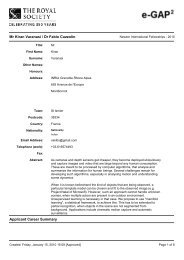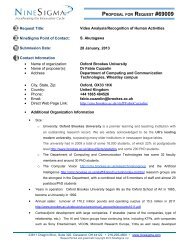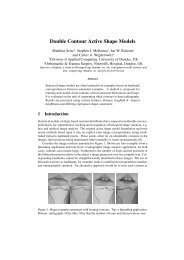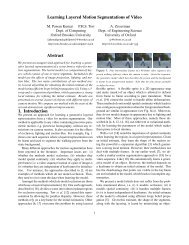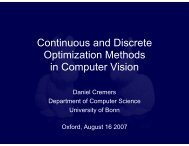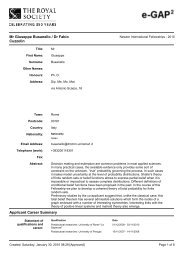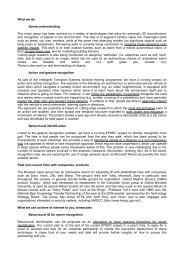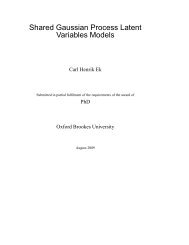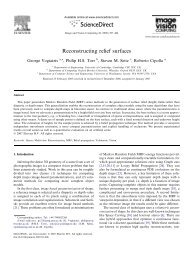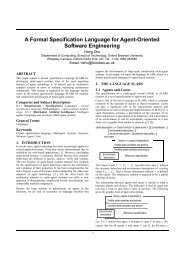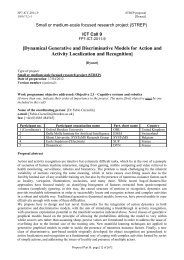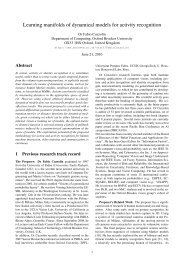Visions of a theory of Imprecise Probabilities VIP - Oxford Brookes ...
Visions of a theory of Imprecise Probabilities VIP - Oxford Brookes ...
Visions of a theory of Imprecise Probabilities VIP - Oxford Brookes ...
Create successful ePaper yourself
Turn your PDF publications into a flip-book with our unique Google optimized e-Paper software.
Cuzzolin Part B section1 (B1) <strong>VIP</strong><br />
probabilities induced by multi-valued mappings. Given a probability distribution p on a given domain, and a<br />
one-to-many map x → Γ(x) to another domain, the original probability induces a probability distribution on<br />
the power set <strong>of</strong> the second collection [Dempster67], i.e., a “random set” [Matheron75, Nguyen78]. The term<br />
“belief function" (BF) was coined when Glenn Shafer [Shafer76, Shafer79] adopted these mathematical<br />
objects to represent evidence in the framework <strong>of</strong> subjective probability, and gave an axiomatic definition <strong>of</strong><br />
them as non-additive (indeed, super-additive) probability measures. Belief functions can be also seen as<br />
“inner measures” [Fagin89], or as “sum functions” on the power set. In a rather controversial interpretation,<br />
rejected by many (including Shafer), belief functions can also be seen as a special case <strong>of</strong> credal set: as they<br />
determine a lower and an upper bound to the probability <strong>of</strong> each event A, they are naturally associated with<br />
the convex set <strong>of</strong> probabilities which “dominate” them: {P : P(A) ≥ Bel(A) ∀A}. The main (but not the only)<br />
problem with this interpretation is that it is not compatible with Shafer's original proposal (“Dempster's<br />
rule”) for the combination <strong>of</strong> BFs generated by different pieces <strong>of</strong> evidence.<br />
The <strong>theory</strong> <strong>of</strong> belief functions is appealing because it addresses all the above mentioned issues with<br />
the handling <strong>of</strong> uncertainty: it does not assume an infinite amount <strong>of</strong> evidence to model imprecision, but uses<br />
all the available partial evidence; it represents ignorance in a natural way, by means <strong>of</strong> the mass assigned to<br />
the whole decision space or “frame”, and deals with the problem <strong>of</strong> having to represent uncertainty on<br />
different but compatible domains; it does not need to resort to any specific “model” to enable us to make<br />
deductions on the observed phenomenon, but preserves the appropriate level <strong>of</strong> uncertainty at all stages <strong>of</strong><br />
the calculations; it copes with missing data in the most natural <strong>of</strong> ways.<br />
Furthermore: its rationale is rather neat and simple; it is a straightforward generalization <strong>of</strong> probability<br />
<strong>theory</strong>, and it does not require to abandon the notion <strong>of</strong> event (like Walley's imprecise probability <strong>theory</strong><br />
[Walley91]); it contains as special cases fuzzy set <strong>theory</strong> and possibility <strong>theory</strong>.<br />
Goals <strong>of</strong> the project. The rationale for a mathematical <strong>theory</strong> <strong>of</strong> imprecise probabilities is therefore<br />
quite apparent. The <strong>theory</strong> <strong>of</strong> belief functions, with its relative simplicity, its multiple semantic and<br />
mathematical interpretations, its generalization potential, is arguably one <strong>of</strong> the most developed such<br />
theories, and a most serious candidate for the job.<br />
Tools for inferring belief functions from the data or making decisions with them have been developed. The<br />
number <strong>of</strong> applications <strong>of</strong> the <strong>theory</strong> <strong>of</strong> evidence to engineering, business, artificial intelligence or robotics<br />
have been steadily growing in the last thirty years.<br />
However, the diffusion <strong>of</strong> such applications and even the interest <strong>of</strong> the statistical community in the related<br />
techniques seem to have reached a plateau. This is the signal <strong>of</strong> a crisis, possibly, as we claim in the abstract,<br />
a blessing in disguise, that needs to be addressed. Indeed, the <strong>theory</strong> <strong>of</strong> belief functions is not yet entirely a<br />
viable alternative to traditional probability <strong>theory</strong> in the Bayesian framework. The existing community has a<br />
tendency to focus on very interesting but somehow self-indulgent new theoretical results. Feedback from<br />
real-world applications is <strong>of</strong>ten missing. Many <strong>of</strong> what are, in our opinion, crucial questions that need to be<br />
addressed in order for practitioners to find the framework easy and convenient to use are being somehow<br />
neglected. Others have been well known for a long time, but are still far from a satisfactory resolution, <strong>of</strong>ten<br />
due to an over-abundance <strong>of</strong> proposal solutions rather than the opposite.<br />
A second effort is needed to address a number <strong>of</strong> crucial issues which currently impair the formalism and its<br />
practical application, in order to make the <strong>theory</strong> <strong>of</strong> evidence a fully fledged mathematical <strong>theory</strong> <strong>of</strong><br />
uncertainty and spread its adoption in the manifold fields <strong>of</strong> applied science. We list them below.<br />
1- some <strong>of</strong> what are the crucial steps in any inference chain have been hotly debated in the past, and a<br />
settled resolution <strong>of</strong> many critical steps <strong>of</strong> belief calculus is not yet in sight;<br />
2- the <strong>theory</strong> is still incomplete under several points <strong>of</strong> view: fundamental mathematical tools, such as the<br />
total probability theorem and related issues are just not there;<br />
3- when compared with the Bayesian formalism, belief calculus lacks a number <strong>of</strong> techniques which, even<br />
though they cannot be classified as “fundamental”, are a sign <strong>of</strong> the significant development the Bayesian<br />
framework has gone through, and a valuable array <strong>of</strong> tools for practitioners: examples are Maximum A<br />
Posteriori, Maximum Likelihood, Expectation-Maximization estimation, Monte-Carlo methods;<br />
4- field testing <strong>of</strong> the different proposals has been neglected, leading to a certain degree <strong>of</strong> disconnection<br />
between theoretical debates and the reality <strong>of</strong> applications;<br />
5- at the opposite end <strong>of</strong> the spectrum, the mathematical properties <strong>of</strong> belief functions in their finite and<br />
continuous formulations are not yet entirely understood; the same holds for important links with many other<br />
fields <strong>of</strong> mathematics, such as linear algebra, combinatorics, geometry, discrete mathematics.<br />
The goals <strong>of</strong> the proposed research project reflect all such questions, and can be outlined as follows:<br />
1- a contribution to the resolution <strong>of</strong> the current ongoing debates on several crucial stages in the inference<br />
chain (illustrated below);<br />
8



